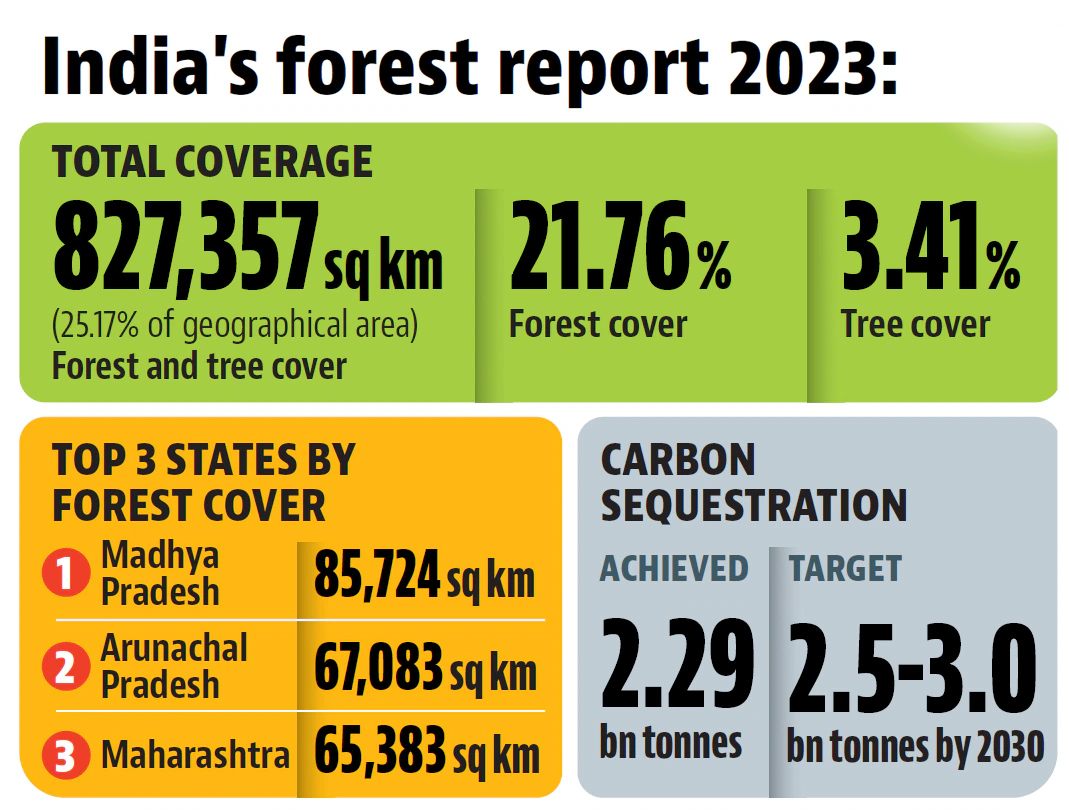Context:
According to the SBI Research Report, India has emerged as one of the top 10 countries globally that have recorded a notable increase in forest area in recent years.
Key Findings of the Report:
Forest Area Trends:
India’s forest cover was stable from 1991 to 2011. Since then, it has seen a rise, attributed to urban greening, sustainable land-use, and afforestation efforts.
Urbanization and Forest Cover:
The report identifies a U-shaped relationship:
- Early urbanization leads to deforestation.
- Advanced urbanization (beyond 40%) results in forest gain due to green policies and planning.
India’s urban population rose from 31.1% (2011) to a projected 35–37% (2024), nearing the tipping point where urbanization positively affects forest cover.
Government Initiatives:
To capitalize on this trend, India has launched several national programs aimed at integrating green infrastructure with urban development, including:
-
Smart Cities Mission
-
Atal Mission for Rejuvenation and Urban Transformation (AMRUT)
These programs aim to enhance urban ecological resilience by promoting urban forests, green belts, parks, and sustainable land use.
Forest Area in Indian Mega Cities:
India’s mega cities have 511.81 sq km of forest area (10.26% of their total area).
- Delhi leads, followed by Mumbai and Bengaluru.
- Forest gains: Ahmedabad, Bengaluru
- Forest losses: Chennai, Hyderabad
Economic Significance:
India is estimated to have 35 billion trees, yet the Gross Value Added (GVA) per tree is just ₹100. The forestry sector contributes about 1.3–1.6% to India’s GVA, supporting critical industries such as:
- Furniture manufacturing
- Construction
- Paper and pulp industry
This signals an opportunity for value enhancement through better forest management and innovation in forest-based industries.
About India State of Forest Report 2023:
Key Findings
· Total Forest & Tree Cover: 8,27,357 sq km (25.17% of India’s geographical area)
o Forest Cover: 7,15,343 sq km (21.76%)
o Tree Cover: 1,12,014 sq km (3.41%)
Increase Since 2021
· Total rise: 1,445 sq km
o Forest cover up by 156 sq km
o Tree cover up by 1,289 sq km
Top Performing States
· Chhattisgarh (+684 sq km), Uttar Pradesh (+559), Odisha (+559), Rajasthan (+394)
· Mizoram led forest cover growth with +242 sq km
States with Largest Cover
· Madhya Pradesh (85,724 sq km), Arunachal Pradesh (67,083), Maharashtra (65,383)
· Lakshadweep has the highest forest cover percentage (91.33%)
Other Highlights (changes since 2021 to 2023)
· Mangrove cover: 4,992 sq km
· Carbon Stock: Increased by 81.5 million tonnes, now totaling 7,285.5 million tonnes, aiding India’s NDC carbon sink goal
· Bamboo Area: Grew by 5,227 sq km, now 1,54,670 sq km
· Timber Potential: Estimated 91.51 million cubic meters annually from trees outside forests
Way Forward:
The SBI report outlines several strategies to enhance forest sustainability:
- Expanding biodiversity hotspots
- Encouraging private sector involvement in afforestation
- Leveraging CSR and carbon credit markets for conservation funding
- Using satellite technology and digital databases to prevent forest encroachment
- Strengthening institutional capacity for monitoring and enforcement
These steps align with India’s commitment to its climate goals under international frameworks such as the Paris Agreement and its Nationally Determined Contributions (NDCs).







